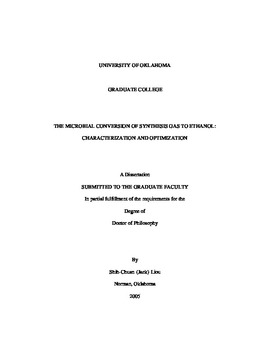| dc.contributor.advisor | Tanner, Ralph S., | en_US |
| dc.contributor.author | Liou, Shih-chuan (jack). | en_US |
| dc.date.accessioned | 2013-08-16T12:19:52Z | |
| dc.date.available | 2013-08-16T12:19:52Z | |
| dc.date.issued | 2005 | en_US |
| dc.identifier.uri | https://hdl.handle.net/11244/895 | |
| dc.description.abstract | By screening 310 enrichments from 37 different sources of inocula (e.g., sediments, lagoons, compost, silage, and animal feces), seven potential microbial candidates (strain P7, P11, P14, P20, P21, MU1 and SK1) were isolated for the conversion of synthesis gas to ethanol The research presented herein focuses on Clostridium carboxidivorans strain P7 and is centered on three main topics: phylogeny, microbial physiology, and development for industrial scale purposes. (Abstract shortened by UMI.) | en_US |
| dc.description.abstract | As a result of the oil crisis of the 1970's, national research began to explore alternatives to petroleum-based energy sources. Initiatives sponsored by the Department of Energy (DOE) have encouraged the transition from petroleum-based to bio-based energy. DOE projections estimate that products and/or processes based on biological raw materials will replace 10% of the demand on fossil fuels by year 2020. One aspect of this policy has targeted research involving biomass-based energy products not only to limit greenhouse gas emissions but for economic development in rural areas. Traditionally, agricultural crops have served as sources of raw materials (i.e., for the bioconversion to ethanol) such as corn starch and beet sugar (the most prominent bio-based energy product). However, lignocellulosic biomass can also be converted to ethanol by an indirect fermentation process, in which biomass is first gasified (similar to coal gasification, producing carbon monoxide (CO)), followed by fermentation of the carbon monoxide to ethanol. Whereas this process offers a more cost efficient way to bioproduce ethanol, many challenges exist in optimizing synthesis gas fermentation. Microbial strain development through increasing cell densities as well as overcoming the effects of inhibitory synthesis gas constituents are required before large scale fermentation can go online. Microbial enhancements and process improvements have thus far been limited by the number of viable candidates with much of the current work focused on acetogens or butyric acid bacteria as potential microbial catalysts for synthesis gas fermentation. Hence, our research objectives concentrated on the enrichment, isolation and characterization of anaerobic microorganisms capable of the conversion of carbon monoxide to ethanol. | en_US |
| dc.format.extent | xii, 102 leaves : | en_US |
| dc.subject | Alcohol. | en_US |
| dc.subject | Biomass conversion. | en_US |
| dc.subject | Engineering, Environmental. | en_US |
| dc.subject | Fuel switching. | en_US |
| dc.subject | Biology, Microbiology. | en_US |
| dc.title | The microbial conversion of synthesis gas to ethanol: Characterization and optimization. | en_US |
| dc.type | Thesis | en_US |
| dc.thesis.degree | Ph.D. | en_US |
| dc.thesis.degreeDiscipline | Department of Microbiology and Plant Biology | en_US |
| dc.note | Source: Dissertation Abstracts International, Volume: 66-05, Section: B, page: 2409. | en_US |
| dc.note | Adviser: Ralph S. Tanner. | en_US |
| ou.identifier | (UMI)AAI3174449 | en_US |
| ou.group | College of Arts and Sciences::Department of Microbiology and Plant Biology | |
